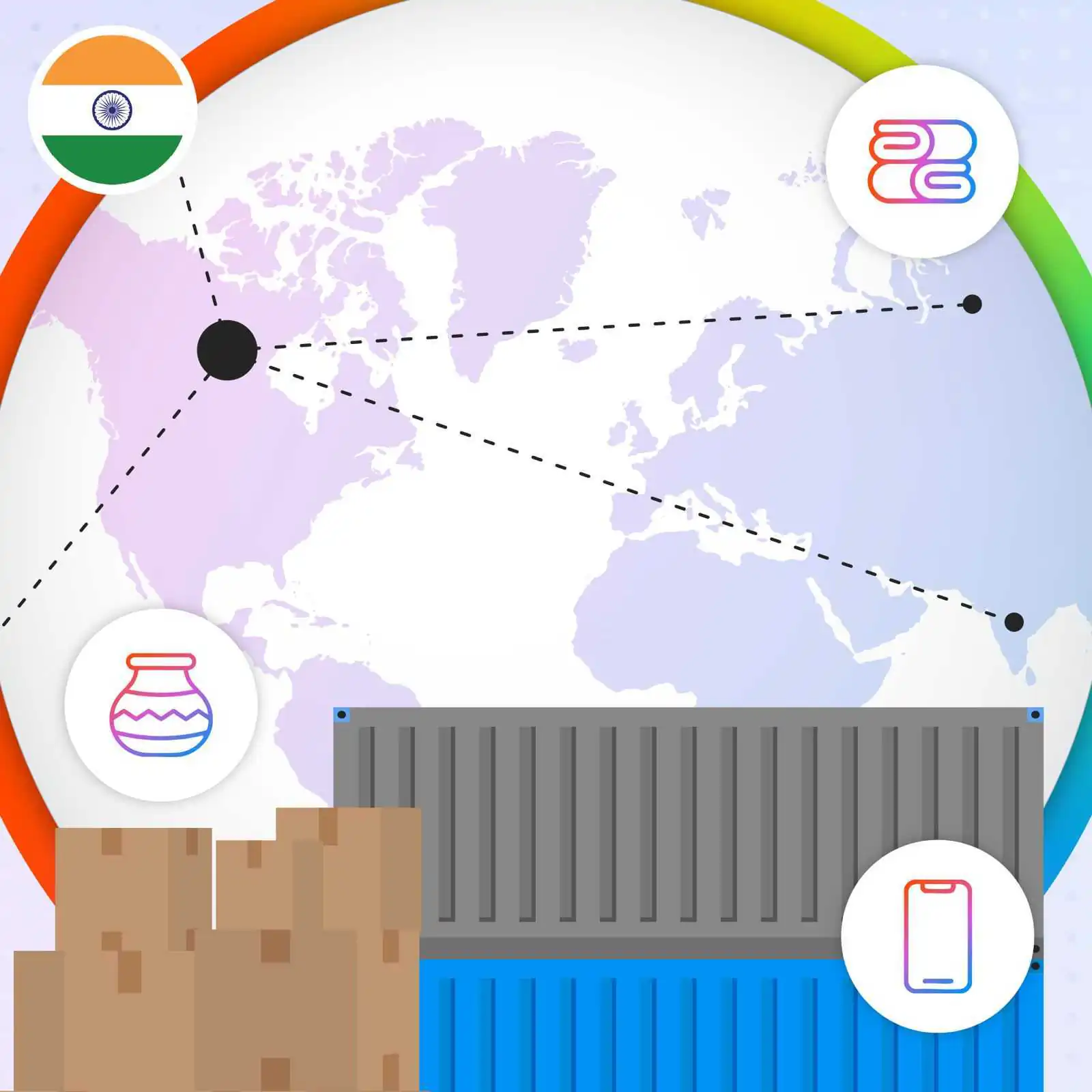US Tightens Import Rules: How Indian Exporters Can Stay Competitive
The U.S. has suspended its $800 de minimis duty exemption, meaning all shipments will now face import duties. This policy shift impacts Indian exporters in textiles, jewellery, handicrafts, and wellness. Adapting pricing, logistics, and exploring new markets will be key for small businesses to stay competitive.

The US has suspended its de minimis duty exemption, ending duty-free treatment for shipments under $800. Starting August 29, all shipments to the US, regardless of value, will be subject to import duties. This affects parcels from India, Greater China, Vietnam, and other countries.
For Indian small and medium-sized businesses (SMBs) selling handicrafts, textiles, and consumer goods through global marketplaces, this means immediate cost increases on every shipment to US customers. Indian SMBs across sectors, from jewellery and handicrafts to textiles and wellness products, now face higher costs when selling to US customers.
This change could reshape how Indian sellers approach the US market. Delaying adaptation could cost sales but understand the new landscape and adjusting strategically can help maintain competitiveness. As businesses navigate these changes, efficient cross-border solution become critical for managing tighter margins and exploring new opportunities.
What is the De Minimis Rule?
To grasp the magnitude of this change, it’s essential to understand what the de minimis rule meant for cross-border commerce. For years, this exemption served as the backbone of affordable international shipping, enabling small sellers worldwide to compete in the US market.
The de minimis exemption, established under Section 321 of the US Tariff Act, allowed shipments valued under $800 to enter the United States without paying import duties. This threshold increased from $200 to $800 in 2016, specifically to facilitate e-commerce growth.
The scale was massive. In 2023, over 1 billion packages entered the US duty-free under this rule. That’s roughly 2.7 million packages every single day, bypassing duty payments.
Why did this matter for the small sellers?
- Kept prices competitive by avoiding duties on $50 to $300 orders
- Cut customs papeerwork from days to hours, which sped up delivery
- Let niche Indian sellers, such as Jaipur jewelers or Moradabad brass artisans, compete with larger importers
The de minimis rule transformed global e-commerce by leveling the playing field for small businesses. Now, with its suspension looming, sellers must understand exactly what changed and why policymakers made this dramatic shift.
See What’s Changed — And Why The US Ended Duty-Free Imports?
The US government’s decision to suspend de minimis treatment resulted from mounting pressure across multiple fronts. Understanding these drivers helps sellers anticipate future policy directions and prepare accordingly.
The executive action suspending de minimis treatment applies to all countries without exception. Effective August 29, imported goods valued at or under $800 will be subject to all applicable duties.
Several factors drove this dramatic policy shift:
- Trade deficit concerns with the US importing $3.1 trillion worth of goods in 2023
- Protection of domestic manufacturing
- Security and compliance issues as CBP processed more than 1.36 billion de minimis shipments in fiscal year 2024
- Political pressure in an election year
The global context makes the US decision particularly striking. The EU charges duties on shipments above €150 and the UK above £135, which made the US$800 limit unusually high by comparison.
This policy reversal creates immediate challenges for Indian sellers who built their US business models around duty-free shipping. The impact varies significantly by product category and price point, making it crucial to understand sector-specific implications.
How Does the US de minimis Suspension Impact Indian Small Sellers?
Indian SMBs face multiple challenges from the de minimis suspension, with some sectors hit harder than others. The impact varies by product category and price point. Understanding these differences helps sellers adapt their strategies.
Most affected product categories:
- Textiles & Apparel ($50-300 range): Cotton garments, ethnic wear, scarves
- Handicrafts & Home Décor ($30-200): Brass items, wooden crafts, wall hangings
- Jewelry ($20-150): Silver jewelry, fashion accessories
- Leather Goods ($40-250): Wallets, bags, belts
- Ayurvedic/Wellness Products ($25-100): Essential oils, herbal supplements
A Jaipur jewelry maker selling $75 silver earrings now faces 5-10% duty. A Bangalore-based organic textile seller’s $150 bedsheet sets become 7-15% more expensive. For businesses operating on 20-30% margins, this reduces profit margins.
The volume impact is substantial. In fiscal year 2023, the United States was the biggest export destination for Indian textile and apparel products with a 29 percent share. India’s textile export declined to US$34.4 billion in FY 2023-24, and the de minimis suspension could accelerate this trend.
Beyond the direct cost impact, sellers must also navigate significant operational hurdles that affect their day-to-day business. These challenges compound the financial pressure and require immediate attention.
The operational challenges:
- Increased compliance costs for proper HS code classification
- Need for formal customs entries even for small shipments
- Customs checks could add three to five days to delivery timelines
- Cash flow pressure from duty payments
While these challenges seem daunting, Indian exporters have proven remarkably resilient in past trade disruptions. History offers valuable lessons on how businesses can adapt and even thrive amid policy changes.
Learning from History: Past Trade Adaptations
Past trade disruptions provide a roadmap for navigating current challenges, showing that Indian businesses possess remarkable adaptability. The key lies in understanding what worked before and applying those lessons to today’s situation.
During the 2018-2019 US-China trade tensions, Indian exporters gained $755 million in additional exports as buyers diversified. When India lost GSP status in 2019:
- Initial impact: $5.6 billion in exports affected
- Adaptation: Product innovation and quality improvements
- Result: Many categories saw volume growth despite higher costs
The Tirupur textile cluster pivoted to sustainable fashion, commanding premium prices. Moradabad brass exporters created designer collections, offsetting the duty impact. When US tariffs hit China in 2018, Indian apparel exporters responded by launching sustainable fashion lines that fetched higher prices.
These historical precedents show that although the de minimis suspension is challenging, it also creates space for exporters to differentiate and innovate. The next step is to identify alternative markets where Indian products can adapt and grow without high import duties.
Where to Sell Next: Top Export Markets for Indian SMBs Beyond the US
As the US market becomes more expensive to serve, smart sellers aren’t waiting to explore alternatives. Markets across Asia, the Middle East, and Europe are actively seeking Indian products, often with simpler import procedures and growing consumer bases. Here’s where Indian SMBs are finding success right now, with specific entry strategies for each region.
High-potential markets:
- Middle East: Growing e-commerce, cultural affinity for Indian products
- UAE: 50 AED ($13.60) de minimis threshold, but strong demand
- Saudi Arabia: Vision 2030 driving consumer spending
- Europe: Despite lower thresholds, a premium market for sustainable/handmade goods
- Southeast Asia: Rising middle class, appreciation for Indian crafts
- Australia/Canada: Strong Indian diaspora, favorable trade relations
India’s expansion strengths:
- ODOP programs helping clusters like Moradabad brassware reach UAE buyers faster
- Digital payment rails like UPI make small-value exports easier to settle
- Over seven million craftspeople produce unique, hard-to-replicate goods
- English fluency helps sellers quickly adapt listings for new markets
Over 150,000 Indian exporters have cumulatively sold more than 400 million ‘Made in India’ products globally. By aggregating Indian SMBs, cross-border marketplaces can facilitate superior transaction experiences for international buyers.
While exploring new markets is crucial, sellers must also optimize their US operations to remain competitive. The right strategies can help absorb duty impacts and maintain profitability.
How to Keep Your Export Business Profitable After US Duty Changes
Sellers need both short-term adjustments and long-term planning to maintain competitiveness in this new environment.
Immediate tactical responses:
Pricing strategies:
- Bundle complementary items so that the added duty spreads over a higher order value
- Show duty-inclusive prices on marketplace listings
- Highlight features that US buyers cannot get locally
Operational optimizations:
- Consolidate shipments where possible
- Explore US fulfillment centers (FBA or 3PL)
- Ensure accurate HS code classification to minimize duties
Market diversification:
- Test new geographic markets systematically
- Develop premium product lines for duty-inclusive pricing
- Reward repeat US buyers with free shipping on their second orders
Leveraging technology and partnerships:
- Use multi-currency accounts to hedge currency risks
- Implement automated compliance tools
- Partner with logistics providers specializing in duty optimization
Technology and financial tools are no longer optional extras but essential survival tools. Indian SMBs using automated compliance systems report 30% time savings on documentation, while those with multi-currency accounts avoid 2-3% in conversion losses per transaction. Here’s how successful exporters are combining these tools with smart operational changes to maintain their margins despite new duties.
Managing Cross-Border Payments in the Post-De Minimis Era
As margins tighten and operations become more complex, having the right financial infrastructure becomes essential. Efficient payment processing and currency management can offset some cost pressures from new duties.
When managing tighter margins from duty costs, efficient payment processing becomes essential. Payoneer’s multi-currency account allows sellers to hold funds in US dollars, euros, British pounds, and seven other major currencies, helping manage currency conversion costs when performing transactions. With operations in 190+ countries and territories, Payoneer supports sellers exploring alternative markets beyond the US.
Over 61 per cent of surveyed Indian SMBs identified technological advancements as key drivers for better global exposure. Having a unified platform for managing payments across multiple markets becomes even more valuable when sellers need to diversify beyond the US market.
The path forward requires both strategic vision and practical execution. Understanding what needs to be done is only the first step toward actual implementation.
Beyond De Minimis: Charting the Path Forward for Indian Exporters
The de minimis suspension represents a significant change in U.S. import policy that will affect cross-border commerce in the coming years. Indian SMBs must now pivot quickly to adjust and expand their strategies.
To adapt, sellers should calculate their new landed costs with duties included and adjust pricing where needed. Exploring markets beyond the US can help offset the impact. Consider the Middle East, Europe, and Southeast Asia as alternatives. Operational improvements like order bundling and consolidated shipping can also help manage increased costs.
The immediate priority is auditing your current US product mix and calculating duty-inclusive pricing. Identify which products remain profitable and which need restructuring. Simultaneously, begin testing alternative markets with your best-performing products.
While the US market becomes more complex, the global opportunity for Indian craftsmanship and products remains strong. With the right tools for managing payments, currencies, and working capital, Indian exporters can navigate this transition and emerge positioned for sustainable growth across multiple markets.
Disclaimer
Nothing herein should be construed as if Payoneer Inc. or its affiliates are soliciting or inviting any person outside the jurisdiction where it operates/is licensed to engage in payment services provided by Payoneer Inc. or its affiliates, unless permitted by applicable laws. Any products/services availability are subject to customer’s eligibility. Not all products/services are available in all jurisdictions in the same manner. Depending on your eligibility, you may be offered with the Corporate Purchasing Mastercard, issued by First Century Bank, N.A., under a license by Mastercard® and provided to you by Payoneer Inc., or the Payoneer Business Premium Debit Mastercard®, issued and provided from Ireland by Payoneer Europe Limited under a license by Mastercard. The Payoneer Business Premium Debit Mastercard® cannot be used at merchants or ATMs in Hong Kong or for HKD payments. If you are located in the EEA, all Payoneer Services will be provided to you by Payoneer Europe Limited, trading as Payoneer and regulated by the Central Bank of Ireland.
The information in this document is intended to be of a general nature and does not constitute legal advice. While we have endeavored to ensure that the information is up to date and correct, we make no representations or warranties of any kind, express or implied, about the completeness, accuracy, reliability or suitability of the information. In no event will we be liable for any loss or damage including without limitation, indirect or consequential loss or damage, or any loss or damage whatsoever incurred in connection with the information provided.
Related resources
Latest articles
-
Planning to hire employees in Japan? Here’s a quick guide
Looking to hire employees in Japan for your U.S. company? Learn about hiring practices in Japan and how Payoneer Workforce Management makes it easy to hire in Japan.
-
Planning to hire in Hong Kong? Here’s a quick guide
Are you hiring employees in Hong Kong for your U.S. company? Learn about employment in Hong Kong and how Payoneer Workforce Management makes it easy to hire in Hong Kong.
-
Planning to hire in Colombia? Here’s a quick guide
Looking to hire employees in Colombia for your U.S. company? Learn about employment in Colombia and how Payoneer Workforce Management makes it easy to hire in Colombia.
-
Planning to hire employees in Brazil? Here’s a quick guide
Looking to hire employees in Brazil for your U.S. company? Learn about employment in Brazil and how Payoneer Workforce Management helps hire in Brazil.
-
How Startups Can Compete for Global Talent
Discover how startups can attract top global talent without big corporate infrastructure. Learn how EOR and AOR solutions help provide competitive benefits and compliance for international hires.
-
What Founders Need to Know About Liability When Hiring Across Borders
Discover key liability risks for founders hiring internationally, from misclassification to statutory benefits. Learn how AOR and EOR solutions help manage compliance and protect your business.














